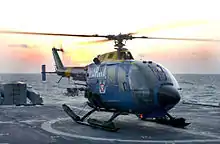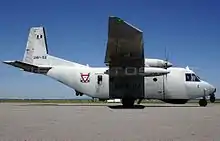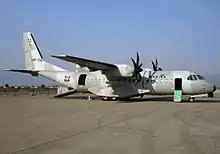Mexican Naval Aviation
Mexican Naval Aviation (FAN; Spanish: Fuerza AeroNaval, literally "Naval Air Force"), is the naval air arm of the Mexican Navy. The Mexican Navy is divided into two naval fleets: Pacific Ocean and Gulf of Mexico.[1][2]
| Mexican Naval Aviation | |
|---|---|
| Fuerza AeroNaval | |
| Active | since 1918 |
| Country | |
| Branch | Mexican Navy |
| Type | Naval aviation |
| Role | Aerial Surveillance, Troop Transport, Search and Rescue |
| Insignia | |
| Roundel |  |
History

Naval aviation in Mexico dates back from 1918, when a Mexican-made float biplane was successfully tested by Carlos Santa Ana at the Port of Veracruz, In 1926 a squadron of float-planes were designed and made for the Mexican Navy, but without personnel. Carlos Castillo Breton, became the first Naval pilot in 1927 after training in The U.S. and in Mexico. Between 1927 and 1943, some aircraft were acquired, and seven naval officers qualified as pilots, some of whom joined the Mexican Air Force. World War II saw the creation of the Naval Aviation school in 1943 at Las Bajadas, Veracruz. These were also ex-FAM aircraft, used to patrol the Gulf of Mexico for German submarines, and were later used for training at the Naval Aviation School.
Years after the war, the role of Mexican Naval Aviation were assigned as supporting the ground and sea naval units in Search & Rescue, coastal patrol and assistance to the general population in case of emergencies or disasters.
1990s
In the 1990s, the Mexican navy started to acquire Russian-built aircraft and helicopters, including the Mil Mi-2, Mil Mi-8 and Antonov An-32B, also purchasing French, U.S. and German-made helicopters and the Finnish-built L-90 Redigo. In 1999 the Mexican navy started a programme to build kit-planes and light helicopters at Las Bajadas, Veracruz.
In 2001 the Mexican naval aviation reported it had 118 aircraft, of which 68 were fixed-wing in 9 squadrons, and 50 helicopters in 9 squadrons, either land-based or on board ocean patrol boats and frigates.
Later purchases were three ex-IDF/AF E-2C Hawkeyes, the first arriving in early July 2004. At the end of the same month, the first two EADS upgraded C212-200 Aviocars flew back to Mexico, with the remaining six being upgraded at BAN Las Bajadas, Mexico. Two AS565 Panther helicopters were purchased for shipborne duties, and delivered in 2005.[3]
Structure
Gulf of Mexico Naval Air Force – HQ in Tuxpan, Veracruz
- Tampico Naval Air Base, Tampico
- 1st Air Mobility, Observation and Transport Naval Air Squadron – operating Mil Mi-17, Lancair IV-P
- 1st Shipborne Patrol Naval Air Squadron – operating AS565 MB, Bo 105CBS-5, MD902
- Las Bajadas Naval Air Base, Veracruz
- 1st Maritime Patrol Naval Air Squadron – operating CASA C-212PM
- 1st Early Warning and Reconnaissance Naval Air Squadron – operating E-2C Hawkeye 2000
- Naval Aviation School – operating MD 500, Robinson R22, Schweizer 300, Zlín Z 42
- Campeche Naval Air Base, Campeche
- Chetumal Naval Air Base, Chetumal
- 1st Patrol Naval Air Squadron – operating Lancair Super ES, MX-7-180A, RC695
- 3rd Air Mobility, Observation and Transport Naval Air Squadron – operating Mi-8

Pacific Naval Air Force – HQ in Manzanillo, Colima
- Guaymas Naval Air Base, Guaymas
- La Paz Naval Air Base, La Paz
- 2nd Patrol Naval Air Squadron – operating RC695, Lancair IV-P
- 2nd Air Mobility, Observation and Transport Naval Air Squadron – operating Mi-8
- 2nd Shipborne Patrol Naval Air Squadron – operating Bo 105CBS-5
- 2nd Transport Naval Air Squadron – operating An-32B
- Lázaro Cárdenas Naval Air Base, Lázaro Cárdenas
- Acapulco Naval Air Base, Acapulco
- Salina Cruz Naval Air Base, Salina Cruz
- Tapachula Naval Air Base, Tapachula
- 4th Patrol Naval Air Squadron – operating Mi-8
- 4th Air Mobility, Observation and Transport Naval Air Squadron – operating MX-7-180A, Super Lancair ES
Mexico City Naval Air Base
- 1st Transport Naval Air Squadron – operating Gulfstream G450, Learjet 25, Learjet 31, Learjet 60, DHC-8-Q202
Aircraft
Current inventory
.jpg.webp)

.jpg.webp)
| Aircraft | Origin | Type | Variant | In service | Notes | |
|---|---|---|---|---|---|---|
| Maritime Patrol | ||||||
| King Air | United States | surveillance | 350 | 5[4] | ||
| CASA C-212 | Spain | maritime patrol | 8[4] | |||
| CASA CN-235 | Spain / Indonesia | maritime patrol / SAR | 6[4] | equipped with a thermal imaging camera for surveillance | ||
| Transport | ||||||
| Cessna 208 | United States | utility / transport | 1 on order[4] | |||
| Cessna 402 | United States | utility / transport | 2[4] | |||
| Super King Air | United States | utility transport | 350 | 3 | 1 on order[4] | |
| CASA CN-235 | Spain / Indonesia | maritime patrol / SAR | 6[4] | |||
| Bombardier Dash 8 | Canada | maritime patrol / SAR | 1[4] | |||
| Turbo Commander | United States | transport | 5[4] | |||
| Helicopters | ||||||
| Mil Mi-17 | Russia | utility | 24[4] | |||
| MD Explorer | United States | utility | 5[4] | |||
| Sikorsky UH-60 | United States | utility | UH-60M | 9[4] | ||
| Eurocopter EC725 | France | SAR / utility | 3[4] | |||
| Eurocopter AS565 | France | SAR / utility | 13[4] | |||
| Eurocopter AS555 | France | utility | 2[4] | |||
| Trainer Aircraft | ||||||
| Zlín Z 42 | Czech Republic | trainer | 242 | 27[4] | ||
| Zlin Z 43 | Czech Republic | trainer | 143 | 2[4] | ||
| T-6 Texan II | United States | trainer | T-6C+ | 13[4] | ||
| Lancair ES | United States | basic trainer | 2[4] | |||
| Hughes 269 | United States | trainer | 4[4] | also used for shore patrol | ||
| Robinson R44 | United States | rotorcraft trainer | 1[4] | |||
| Robinson R22 | United States | rotorcraft trainer | 1[4] | |||
| Sikorsky S-333 | United States | rotorcraft trainer | 10[4] | |||
| MD 500 Defender | United States | rotorcraft trainer | 3[4] | |||
See also
References
- "Archived copy". Archived from the original on 31 August 2009. Retrieved 31 August 2009.CS1 maint: archived copy as title (link)
- "Archived copy". Archived from the original on 1 September 2009. Retrieved 16 August 2009.CS1 maint: archived copy as title (link)
- "Mexican Naval Air Arms". Scramble. Archived from the original on 23 March 2008.
- "World Air Forces 2019". Flightglobal Insight. 2019. Retrieved 12 May 2019.